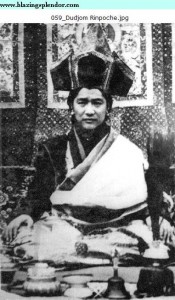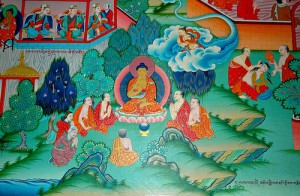The following is respectfully quoted from “Perfect Conduct: Ascertaining the Three Vows” by Ngari Panchen with commentary by Dudjom Rinpoche as translated by Khenpo Gyurme Samdrub and Sangye Khandro
The initial virtue, the intermediate virtue, and the concluding virtue are the three divisions in this and in all commentaries that are written based on the Buddha’s spoken teachings. These three divisions are similar to the three pure recollections: those of motivation, nonconceptual awareness during the actual practice, and the concluding dedication of merit. In the initial virtue there are the three divisions that explain the title of the text, the homage, and the commitment to compose.
I. The Title of the Text:
A Branch on the Path of the Natural Great Perfection Called Ascertaining the Three Vows
Within the profound expanse of the innate, unaltered, natural mind, all meanings, including the foundation, path, and result, are originally perfected. This spontaneous presence, which is unsurpassed by any other, is called “great.” The unmistaken actualization of this nature is the ultimate fruit of all paths, the atiyoga. From anuyoga on down, all the paths of sutra and tantra are practiced in order to realize this nature. In this way they are established as “branches” of the path. The three vows, the essence of the practice of all these paths, are the main subject at hand. To establish an accurate understanding of the view of the three vows through the three investigations–actual, inferential, and scriptural–is the meaning of “ascertaining.”
Sastra literally means that which has the potential to sever all negative emotions and grant refuge from rebirth in the three lower realms. Specifically, a sastra is a commentary on the Buddha’s teachings written by a perfect follower. There are three levels to be considered here. Ideally, the author of sastra must have realization of the nature of dharmata. To qualify as average the author should have had a vision of a deity. At least, the author should be perfectly learned in the five major sciences. In addition, the commentary must be eloquently written with the qualities and ability to alleviate the causes of delusion, as well as to produce the results that grant protection from inferior rebirths in cyclic existence.
The purpose of the title will vary according to the sensibility of the reader. Those of superior sensibility, just by reading the title, will be able to realize the entire meaning of the text. Those of average sensibility will derive a general idea of its contents, and those of common sensibility will become interested and inspire to begin to study the text.
II. Homage:
A. General homage to the supremely kind guru:
Namo Guruve!
Homage to the Guru-Lama!
“Namo” means to pay homage. “Guru” describes an individual whose noble qualities are limitless, whose wisdom-knowledge is unsurpassed, and whose great loving-kindness is unequalled. To such a guru-lama, with great admiration and respect from the three doors of body, speech, and mind, homage is rendered.
B. Specific homage to the great master, Padmasambhava:
By churning the treasure ocean of the glorious two accumulations, the white light of knowledge and loving-kindness brings forth the all pervasive rain of the definitive secret vehicle. To the supreme crown jewel of all scholars and accomplished masters of Tibet’s Land of Snow, to the guide of all sentient beings, the Lake-born Vajra (Guru Padmasambhava), I pay homage!
It is believed by the Vedic school of Hinduism that by churning the ocean the moon arose. The author draws from this example to poetically illustrate the qualities of Guru Padmasambhava. By churning the vast ocean of accumulation of ordinary and wisdom merit, supreme wisdom and loving-kindness arise indivisibly, forming the mandala of the moon with its cooling, moist, illuminating rays. The all-pervasiveness of a rain shower is likened to the spontaneity of the concerned action that arises from such a “moon” to reveal the secret mantra teachings in order to tame the minds of beings.
This analogy exemplifies the object of specific homage, the great master Padmasambhava, who is the very embodiment of the great ocean of the two accmulations of merit, the source from which all enlightened qualities of wisdom-knowledge and compassion arise. As the supreme crown jewel of all scholars and accomplished masters in the three realms, including the snow land of Tibet, he is well known as the Lake-born Vajra.
The Lake-born Vajra, Padmasambhava, was born from the center of a lotus without depending on parents. The word “vajra” refers to the transcendence of the concept of birth and death. Because he possesses the wisdom to guide all beings on whatever level is necessary according to their specific needs, he is known as the supreme guide of beings.
III. Commitment to Compose:
This sage, skilled in knowing how to cleanse the mental stains of beings and upholding the lapis lazuli vase of supreme intelligence, bestows the ambrosia-like explanations of the three vows. May all those with sincere interest gather here to partake of this!
The author, Ngari Panchen, refers to himself as a sage, defined as one who is wise in the worldly knowledge of what to accept and reject. As is the case with all scriptural commentaries, the author’s “commitment” must reveal with superiority the four necessities of this Dharma. The first necessity is the subject, in this case the three vows. The second necessity is a superior explanation of the subject so that the meaning and purpose can be fully understood, leading readers to embark upon the path to liberation. This bestows temporary benefit. Fourth, the interdependent relationship between each of these four is demonstrated, in that one arises in dependence upon the other and accomplished accordingly.

